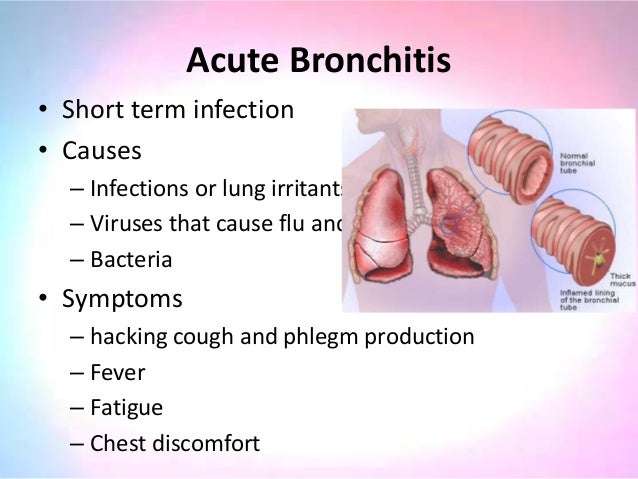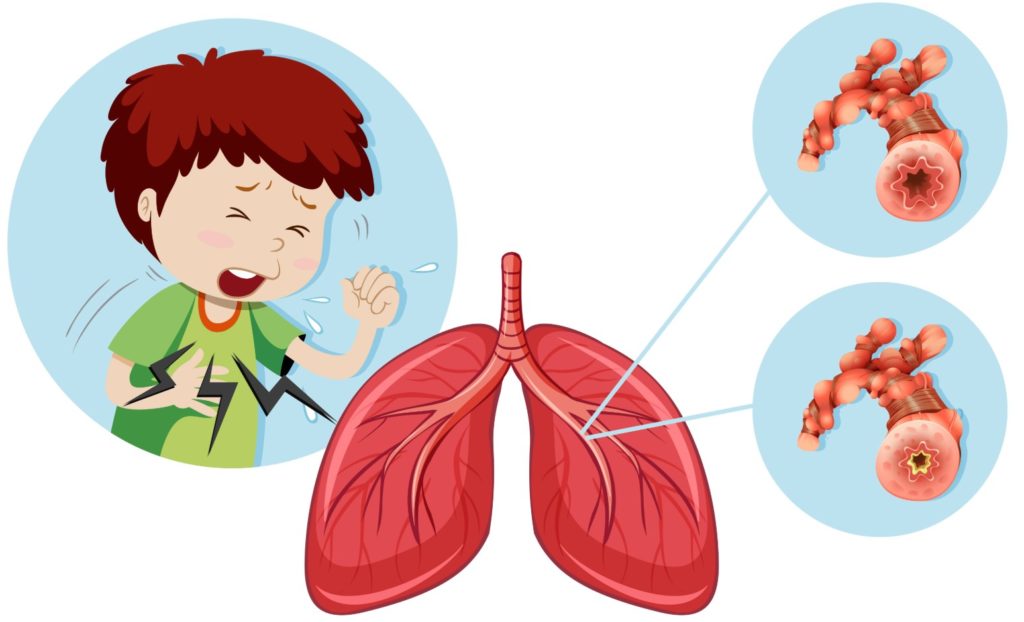The enigma of acute bronchitis in children continues to baffle even the most astute medical professionals. Unlike its adult counterpart, pediatric bronchitis presents with a plethora of perplexing symptoms and diverse causative factors that keep doctors on their toes.

It all begins innocuously enough – a runny nose, perhaps a cough or two. But before you know it, your child is gripped by an overwhelming sense of malaise as they struggle to breathe amidst bouts of wheezing and chest tightness. Other tell-tale signs include high fever, debilitating fatigue, and body aches that leave them feeling drained and lifeless.
If these symptoms persist for more than 14 days, it’s crucial to seek prompt medical attention from a qualified physician who can examine your child’s lungs using a stethoscope. The diagnosis may point towards acute bronchitis which calls for urgent intervention.
Prevention is always better than cure when it comes to this insidious condition. Parents must instill good hygiene habits such as frequent hand washing and maintaining clean surfaces at home. It’s also advisable to steer clear of secondhand smoke or any other irritants that could trigger airway inflammation in susceptible children.
Treatment options range from antibiotics to inhalers depending on the severity of the illness. Home remedies like steam baths and humidifiers can be effective in alleviating congestion while reducing coughing fits, but constant supervision is essential throughout therapy.\n
Understanding Acute Bronchitis: Causes, Symptoms, and Diagnosis
Bronchitis, a respiratory affliction that plagues the young and old alike, can be quite the enigma. As if out of nowhere, acute bronchitis strikes children between six months to five years old with remarkable frequency. Inflammation of air passages leading to the lungs is typically caused by viral infections or exposure to pollution and other irritants.

The coughing which accompanies pediatric bronchitis often begins in a dry fashion before evolving into mucus production as inflammation becomes increasingly severe. Difficulty breathing, wheezing, chest tightness, and fatigue are also common symptoms which may linger for up to four weeks.
It’s imperative that parents and caregivers remain vigilant in identifying signs of this insidious disease so medical attention can be sought without delay. While it’s true some cases may resolve themselves with rest and home remedies such as humidifiers or increased fluid intake; others require medication or even hospitalization for swift resolution. Early detection remains paramount in preventing further complications from unfolding down the line.
Pediatric Bronchitis: How it Differs from Adult Bronchitis
The enigmatic nature of pediatric bronchitis continues to baffle many, as this common childhood illness wreaks havoc on the respiratory system. In stark contrast to its adult counterpart, which often stems from bacterial infections, pediatric bronchitis is primarily viral in origin – rendering antibiotics powerless against it.
Afflicted children may display a range of symptoms including coughing (potentially accompanied by mucus), wheezing, labored breathing and chest pain or discomfort. These symptoms can persist for weeks on end and prove especially troublesome for youngsters under five years old.
Parents are advised to prioritize their child’s hydration levels and rest while also availing them with comfort-enhancing amenities such as humidifiers or over-the-counter medication like acetaminophen or ibuprofen (pending doctor approval).
Chronic bronchitis represents an even more baffling manifestation of pediatric bronchitis where inflammation takes root deep within the airways – causing persistent coughs and respiratory issues that can last months if not years. Tackling these chronic complications mandates close collaboration with healthcare providers to effectively manage symptoms while nipping any potential complications resulting from prolonged lung inflammation in the bud.
Recognizing the Signs and Symptoms of Bronchitis in Children
The recognition of bronchitis signs and symptoms in children is a perplexing matter that leaves parents feeling bewildered. The burstiness of acute bronchitis development can take one by surprise, as this illness often develops rapidly. A cough lasting more than a week should serve as an indication for parents to seek medical attention, as it could be the onset of acute bronchitis. One common culprit for the causes of acute bronchitis is viral infections such as colds or flu.
Bronchitis manifests itself through many unpleasant symptoms including wheezing, chest congestion and difficulty breathing – enough to make any parent feel bamboozled. If these symptoms persist or worsen after several days, seeking professional medical help becomes imperative. Ignoring this red flag may lead to complications like pneumonia; a prospect no parent wants to face.
Children with chronic conditions like asthma or allergies are at higher risk of developing acute bronchitis due to weakened immune systems which adds another layer of bewilderment for parents who are unsure how best to protect their child from this condition’s grasp. Rest and fluids while avoiding smoke exposure and irritants are simple ways that parents can reduce their child’s chances of contracting acute bronchitis.
In summary, recognizing the perplexing signs and symptoms associated with childhood Bronchitis is crucial since early diagnosis leads to prompt treatment which reduces anxiety levels for both children and parents alike. Understanding what triggers Acute Bronchitis allows parents greater scope when taking preventative measures against this common childhood illness. Always remember that seeking medical assistance right away if there is worsening respiratory distress in your child always proves beneficial in the end!
Preventing Acute Bronchitis in Children: Tips and Strategies
The prevention of acute bronchitis in children can be a perplexing task, as inflammation of the bronchial tubes may occur after just a simple cold or viral infection. It’s astounding to think that even children are susceptible to such an ailment, with symptoms including coughing, wheezing, chest tightness and shortness of breath. If your child has been suffering from a chronic wet cough that persists for weeks on end, it’s imperative that you seek the advice of their healthcare provider.
It’s essential to have children with chronic coughs evaluated by their healthcare provider due to underlying conditions like asthma or pneumonia which could be exacerbating their symptoms. An evaluation is often conducted through gathering health history and performing physical examinations; however tests might not always be necessary unless there are concerns about pneumonia or asthma.
Alas! The use of antibiotics to treat acute bronchitis caused by viruses is futile since they do not help fight against viruses. Administering these medicines when they’re unnecessary increases the risk of antibiotic resistance in the future – something no parent wants for their child! Therefore treatments focus solely on relieving symptoms such as using humidifiers or vaporizers at home since light does not get hot enough to cause burns.
In conclusion, evading irritants such as tobacco smoke and air pollution plays a pivotal role in preventing acute bronchitis among children. Additionally encouraging good hand hygiene practices like washing hands frequently helps reduce transmission of respiratory illnesses within families. If your little one displays any signs or symptoms associated with acute bronchitis then prompt medical attention should be sought from their healthcare provider for proper diagnosis and treatment options without giving them medication unnecessarily which could potentially harm them later down the line!
Treating Acute Bronchitis in Children: Medications and Home Remedies
When it comes to treating acute bronchitis in children, the options can seem overwhelming. On one hand, there are medications that may provide relief but not all of them are safe for young ones under four years old. That’s why parents should always consult with their child’s pediatrician before administering any form of medication.
Acute bronchitis is no laughing matter and typically stems from a viral infection that starts in the nose or throat before spreading down to the airways; this makes good hygiene habits even more important. Hand washing, covering coughs or sneezes, and practicing social distancing can help prevent further spread.
That being said, once diagnosed with acute bronchitis, parents have several treatment options to explore such as antibiotics (if bacterial infection is present), cough suppressants or inhalers – though these should be taken only as per medical advice. Home remedies like staying hydrated and using a humidifier could also provide some relief.
It’s essential to remember though that most cases of childhood bronchitis resolve on their own within just a few weeks plus ensuring proper care measures during recovery will go a long way toward preventing chronic conditions from developing later on down the line.
In summary then: while medication might prove helpful in alleviating symptoms associated with acute bronchitis in kids, it must be administered by healthcare professionals only after careful consideration of each case uniquely! Parents too play an active role here by promoting healthy habits at home alongside seeking medical attention when necessary- so don’t hesitate if your little one isn’t feeling well!
Chronic Bronchitis in Children: Causes, Symptoms, and Management
The perplexing nature of chronic bronchitis in children demands continuous management. The symptoms may seem familiar to those of acute bronchitis, but they persist for a staggering 3 to 4 months or even longer each year. If your beloved child experiences such enigmatic symptoms, it is imperative that you seek the assistance of their healthcare provider.
The diagnosis of this mysterious condition requires an intricate medical history inquiry and a physical examination by the healthcare provider. Further tests, including chest X-rays or pulmonary function tests, might be necessary to corroborate the diagnosis.
Treatment options are determined based on the severity of your child’s symptoms and may include medications like bronchodilators or steroids. However, administering cold medicine to children under four years old should never be considered as it could lead to hazardous side effects; likewise, aspirin must not be given without explicit instructions from their healthcare provider.
It is crucial that you monitor any changes closely if new symptoms develop or if there are changes in medication or treatment procedures recommended by your healthcare provider. This becomes especially important when another respiratory infection occurs as it can aggravate chronic bronchitis’ already bewildering indications.
In conclusion, managing chronic bronchitis in children entails meticulous monitoring of signs and working hand-in-hand with their healthcare providers towards an appropriate course of action. Children over six years old have agency over managing their condition by avoiding triggers such as tobacco smoke while practicing good hygiene habits like frequent hand washing. With proper guidance from experts and careful attention paid to its intricacies, most children living with chronic bronchitis can lead healthy lives without significant limitations on daily activities – bursting forth into life’s rich tapestry!
Asthma and Bronchitis in Children: Similarities and Differences
The perplexing reality of respiratory conditions in children is a subject that cannot be ignored. The burstiness of asthma and bronchitis, while seemingly similar with their shared attribute of breathing difficulties, can present stark differences.
When it comes to the origins of these conditions, asthma tends to rear its head in those with allergies or eczema histories. However, bronchitis takes root from colds or other infections. It’s also worth noting that environmental factors like dust and pollen may trigger asthmatic episodes, whereas bacteria or viruses usually cause bronchitis.
Symptoms are another aspect where confusion may arise for parents trying to understand whether their child has asthma or bronchitis. Pediatric bronchitis often manifests as wheezing, coughing fits and difficulty breathing; younger children under 2 years old are more prone to this condition than older kids/teens. Meanwhile, asthma strikes across all age ranges but typically develops early on in childhood – which can persist into adulthood if not properly managed.
It’s crucial that parents recognize symptoms promptly when they appear so medical attention can be sought out swiftly. Proper treatment and management strategies will ensure that children afflicted by either condition can lead healthy lives despite their ongoing health concerns.

